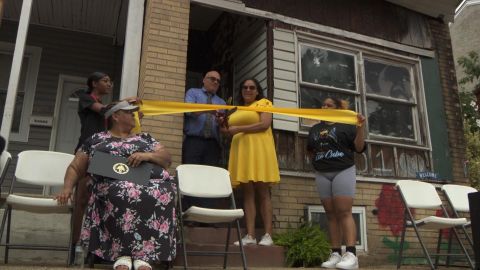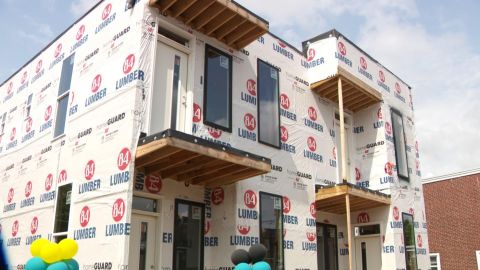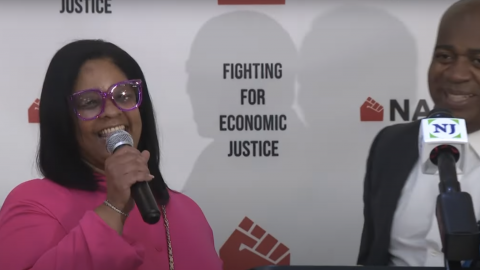WOODRUFF: Very small houses have become all the rage in recent years, as some people trade
in their traditional lifestyles for an ostensibly simpler option: places that are less than
400 square feet.
Well, today, there's a twist.
Tiny houses are being seen as a way to give homeless and low-income people the chance
at homeownership.
Jeffrey Brown visited Detroit to find out more for our ongoing series on poverty and
opportunity in America, "Chasing the Dream."
(BEGIN VIDEOTAPE)
JEFFREY BROWN, PBS NEWSHOUR CORRESPONDENT (voice-over): They may be tiny, but they have
lofty goals: putting roofs over the heads of people who never dreamed they could own
a home.
The idea for Detroit's Tiny Home Project was born in an unlikely place -- the floor of
an old warehouse.
REVEREND FAITH FOWLER, COMMUNITY ACTIVIST: People couldn't imagine what 300 square foot
would look like.
BROWN (on camera): Well, could you?
FOWLER: I couldn't.
(LAUGHTER)
FOWLER: So we came out and measured it out and taped it out and thought, where would
I put the sofa and my bed and is this enough room?
And we decided it would be.
BROWN (voice-over): And now it is.
(on camera): All right.
Here it is.
FOWLER: So, this is one of our studios.
BROWN: Studio, meaning there's no bedroom.
FOWLER: Correct.
BROWN: Yes.
(voice-over): Reverend Faith Fowler is a pastor and community activist working to create jobs
and provide homes for the city's most needy.
FOWLER: Some have large front porches, some have decks or patios in the back.
All have a nice backyard, so they could have a dog or a barbeque or just sit outside and
listen to the traffic.
BROWN: Each of the seven homes built so far has a kitchen, living room, washer/dryer,
and bathroom.
Several have separate bedrooms.
Fowler's non-profit Cass Community Social Services purchased 25 vacant lots from the
city for $15,000.
They're bright spots, literally, in a neighborhood with many vacant, crumbling houses, next to
one of Detroit's busy freeways.
FOWLER: We wanted this to be a part of a larger neighborhood, rather than being segregated,
or separated, or isolated outside of a neighborhood.
BROWN (on camera): Yes, because you drive around, and much of this neighborhood is still
very blighted, right?
FOWLER: It -- often people are worried about gentrification, I'm not so concerned yet.
BROWN: Not an issue here, right?
FOLWER: No.
There hasn't been a new building in this neighborhood since 1974, and it was a garage.
So, you can imagine the excitement of seeing houses go up, like a barn raising here, as
people are coming to watch, and sometimes even offering to volunteer.
BROWN (voice-over): A volunteer workforce built each home in about five weeks, using
donated goods and services.
That kept the cost to around $40,000 to $50,000.
(on camera): The idea here is how to overcome something many of us take for granted -- how
to buy your own home when you have few or no financial assets, and when the whole notion
of owning a home seems impossible.
(voice-over): For those living below the poverty line, and 40 percent of Detroit's residents
do, Fowler says there are plenty of barriers to homeownership.
FOWLER: They don't have enough money to get them through a crisis, so your car breaks
down, or your hours get cut, or you get laid off, or somebody in your family gets sick,
all of a sudden, you don't have enough financial security to get through it, and so all of
a sudden, you're in a crisis that you may not recover from for years, and decades to
come.
BROWN (on camera): But this gives people something that they own.
FOWLER: Right, that they can have the pride of ownership, that they can have the dignity
of using as a home even while they're renting, and ultimately something they can use as collateral
if they have a crisis.
BROWN (voice-over): The new inhabitants here will rent to own.
They'll pay a dollar per square foot in rent.
They're also required to take monthly financial literacy classes and volunteer for the neighborhood
watch.
After seven years, they'll own their homes.
The tiny home trend is booming, fueled in part by cable design shows.
But in those shows, people have made a choice to downsize and live simply.
The Detroit project has a different purpose.
FOWLER: We were really looking for a way to give them a ladder.
I mean, they've got to climb it, they've got to do the work, but we're providing the ladder.
BROWN: The tiny homes are also smack in the middle of a built-in support structure.
Fowler's non-profit runs apartment buildings for people transitioning from being homeless.
There's a bike borrowing service to help people get around.
And there are jobs at Green Industries, for people re-entering the workforce.
The company recycles abandoned tires and more to fashion doormats, flip flops and key chains,
with the old English "D" for the Detroit Tigers.
Kevin Taylor makes coasters out of recycled glass.
He credits his job here as a lifesaver, after struggling with addiction and spending time
in prison.
KEVIN TAYLOR, GREEN INDUSTRIES EMPLOYEE: Well, it changed my life.
I'm employed.
I have my own apartment at this point in life, which is a wonderful thing.
Learning how to live again.
BROWN (on camera): What does that mean?
TAYLOR: Well, that means waking up in the morning, doing normal things that normal people
do, having coffee, breakfast, get ready to go to work, and go to work, come home.
BROWN (voice-over): That's the idea behind the tiny homes as well.
And there's one more idea: that each should look and feel different.
FOWLER: So often when you're considering affordable housing, it's ugly.
BROWN (on camera): Yes, yes.
FOWLER: It's a box, or a rectangle.
It's identical.
There's no colors.
There's no design.
So, again, we wanted it to be attractive, and to instill pride in people.
BROWN (voice-over): And so, different architectural styles, including so far, Cape Cod, Modern,
and Shotgun.
Ed Wier, an architect from Ann Arbor, donated his services to help design a future home
in a Victorian style.
ED WIER, ARCHITECT: Victorian, it's a classic residential -- American residential style,
and, you know, a lot of people are drawn to a very ornate, a lot of detailing, and so,
people just are attracted to it, it appeals to them.
So, obviously we had to scale it back, and kind of, how do we draw these things into
a small house, into a small format?
BROWN: It's hardly the norm for low-income housing.
But, says Wier, that's the point.
WIER: It's a refined, elegant tiny house that somebody would love to live in.
And it feels like home.
What says home to you?
BROWN (on camera): That's the final question, really, right?
WIER: That's the final question.
And I think the goal was that in that, we created something that says home.
BROWN: Yes.
(voice-over): And who will call it home?
After a series of open houses, 122 people applied to live in the tiny homes.
Fowler is waiting on the city to give the green light before announcing the seven chosen
to move in.
In the meantime, 18 more tiny homes are on the way.
It's a small number of small homes, but a big idea.
FOWLER: It's really about home ownership and the American dream for people who stopped
dreaming.
We really were looking at not only eliminating homelessness, but with dealing with poverty
for people.
BROWN: For the PBS NEWSHOUR, I'm Jeffrey Brown in Detroit, Michigan.



